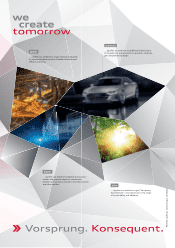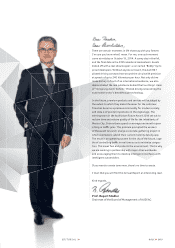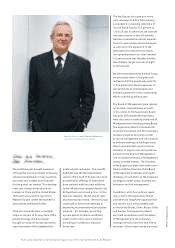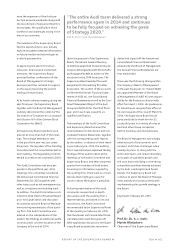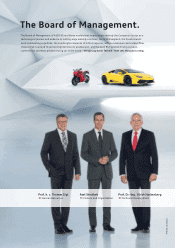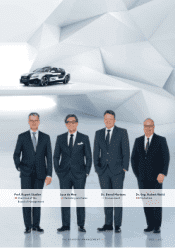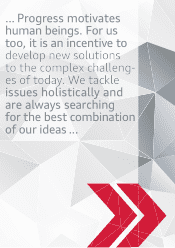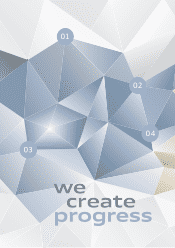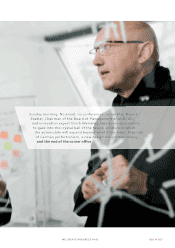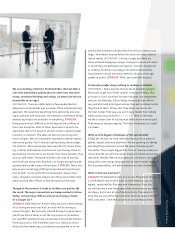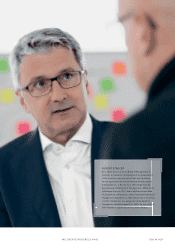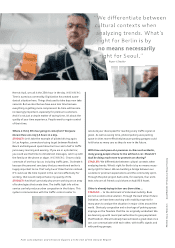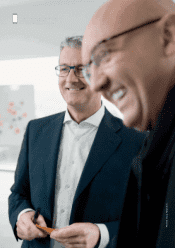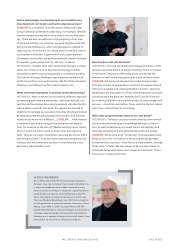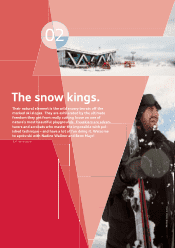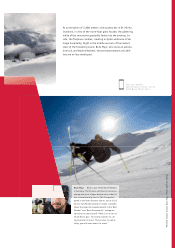Audi 2014 Annual Report Download - page 17
Download and view the complete annual report
Please find page 17 of the 2014 Audi annual report below. You can navigate through the pages in the report by either clicking on the pages listed below, or by using the keyword search tool below to find specific information within the annual report.
We are standing in Berlin’s Humboldt-Box. Named after a
man who embodied a quality that we need more than ever
today : connected thinking and acting. So where are the von
Humboldts of our age ?
WEINBERG : There are defi nitely too few people like him.
Alexander von Humboldt was a pioneer of the interdisciplinary
approach. He researched everything from astronomy and zool -
ogy to bananas and volcanoes. He wanted to understand things
without aspiring to be an expert in everything. STADLER :
Many people fi nd it di cult to think beyond the confi nes of
their own discipline. Most of them have been trained to be
specialists. But in the future it will be crucial to adopt broader
horizons, to network. The tasks we face are becoming ever
more complex. We are meanwhile expected to deliver results
even more quickly. You’ll only succeed by being a team player.
WEINBERG : We’ve previously had a penchant for linear think-
ing, in terms of disciplines and divisions. Just the way those or-
ganizational charts told us we should. Over many decades, that
was our safe haven. Everyone had their own area of activity,
and we all got along well. But that’s no longer enough to ade-
quately address the issues of the future. STADLER : That’s also
why we are increasingly shifting to topic-based project teams
here at Audi. You’ve got technical developers, design engi-
neers, designers and sales experts all sitting around the same
table, pooling their e orts to fi nd the optimum solution.
Though at the moment it looks as if others are quicker o
the mark. The major innovations are being created in Silicon
Valley, not Germany. Will we all soon be driving a Tesla ?
Or a Google Car ?
STADLER : Defi nitely not ! A more likely outcome is that instead
of us driving around in an Audi, an Audi will be driving us
around (laughs). But seriously, piloted driving is a good exam-
ple of how Silicon Valley is not the only source of innovation.
Our Audi RS piloted driving concept went around the Hocken-
heimring at up to kilometers per hour, without a driver.
And just a few weeks ago, journalists accompanied us on an
almost -kilometer piloted drive from Silicon Valley to Las
Vegas. Yesterday’s science fi ction has become today’s techno-
logical reality. WE INBERG : For me, Google and Tesla are
above all about displaying courage. Courage to venture into areas
in which they are defi nitely not experts. I see the Google Car
as nothing more than a prototype. No German automotive
manufacturer would ever have dared to show such an ugly
potato in public. STADLER : Well, you said that (laughs).
So Germans prefer doing nothing to making a mistake ?
WEINBERG : That’s exactly what we teach students and pro-
fessionals to get out of their system in design thinking. The
principle is : Don’t be afraid to make mistakes, but make them
early on. Incidentally, Silicon Valley shares that view. We’re
very quick to build prototypes and we then ask customers what
they think of them. If they don’t like them, we move onto
the next model. That way, you won’t see a model that nobody
wants going into production.
STADLER :
STADLER :
Here in Germany,
we like to steer clear of risk because that’s how we are taught.
That needs to change urgently. The fear of mistakes is in itself
a mistake.
What are the biggest challenges of the next decade ?
STADLER : At Audi we have identifi ed the four focal areas of
global, digital, ultra and premium. We are growing worldwide
and delighting customers around the globe. In keeping with
the motto “The car gets bigger than the car,” we are working on
connecting the car with the overall transport infrastructure and
with other vehicles. We are also cutting CO
emissions. All that,
along with a new design language and an even broader range of
full-size automobiles, will defi ne tomorrow’s idea of premium.
What is this new premium ?
STADLER : Essentially the same as it is now. Progressive design,
a comfortable and modern interior, performance, sports
appeal, sustainability. Plus two new dimensions. First, the
car will become a new living space that serves as your personal
sanctuary, but is also a hub of digital activity. The second is
time. We are one of the few industries that can create time for
their customers. Time that people can use and enjoy more.
PHOTOS : Klaus Mellenthin


